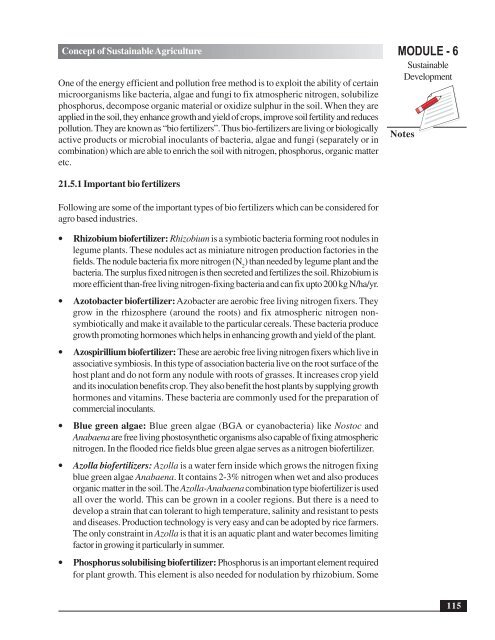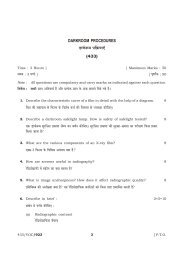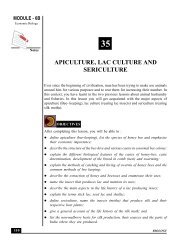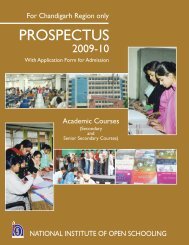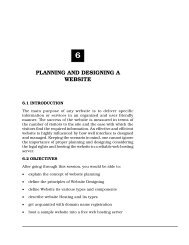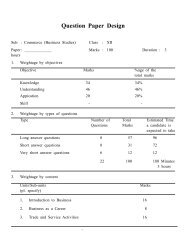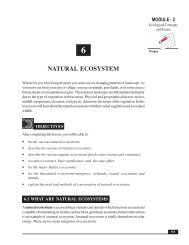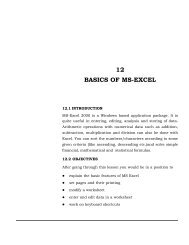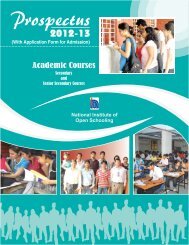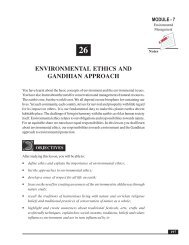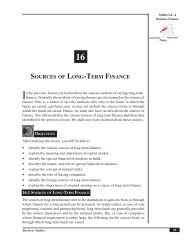Concept of Sustainable Agriculture
Concept of Sustainable Agriculture
Concept of Sustainable Agriculture
You also want an ePaper? Increase the reach of your titles
YUMPU automatically turns print PDFs into web optimized ePapers that Google loves.
<strong>Concept</strong> <strong>of</strong> <strong>Sustainable</strong> <strong>Agriculture</strong>One <strong>of</strong> the energy efficient and pollution free method is to exploit the ability <strong>of</strong> certainmicroorganisms like bacteria, algae and fungi to fix atmospheric nitrogen, solubilizephosphorus, decompose organic material or oxidize sulphur in the soil. When they areapplied in the soil, they enhance growth and yield <strong>of</strong> crops, improve soil fertility and reducespollution. They are known as “bio fertilizers”. Thus bio-fertilizers are living or biologicallyactive products or microbial inoculants <strong>of</strong> bacteria, algae and fungi (separately or incombination) which are able to enrich the soil with nitrogen, phosphorus, organic matteretc.MODULE - 6<strong>Sustainable</strong>DevelopmentNotes21.5.1 Important bio fertilizersFollowing are some <strong>of</strong> the important types <strong>of</strong> bio fertilizers which can be considered foragro based industries.• Rhizobium bi<strong>of</strong>ertilizer: Rhizobium is a symbiotic bacteria forming root nodules inlegume plants. These nodules act as miniature nitrogen production factories in thefields. The nodule bacteria fix more nitrogen (N 2) than needed by legume plant and thebacteria. The surplus fixed nitrogen is then secreted and fertilizes the soil. Rhizobium ismore efficient than-free living nitrogen-fixing bacteria and can fix upto 200 kg N/ha/yr.• Azotobacter bi<strong>of</strong>ertilizer: Azobacter are aerobic free living nitrogen fixers. Theygrow in the rhizosphere (around the roots) and fix atmospheric nitrogen nonsymbioticallyand make it available to the particular cereals. These bacteria producegrowth promoting hormones which helps in enhancing growth and yield <strong>of</strong> the plant.• Azospirillium bi<strong>of</strong>ertilizer: These are aerobic free living nitrogen fixers which live inassociative symbiosis. In this type <strong>of</strong> association bacteria live on the root surface <strong>of</strong> thehost plant and do not form any nodule with roots <strong>of</strong> grasses. It increases crop yieldand its inoculation benefits crop. They also benefit the host plants by supplying growthhormones and vitamins. These bacteria are commonly used for the preparation <strong>of</strong>commercial inoculants.• Blue green algae: Blue green algae (BGA or cyanobacteria) like Nostoc andAnabaena are free living phostosynthetic organisms also capable <strong>of</strong> fixing atmosphericnitrogen. In the flooded rice fields blue green algae serves as a nitrogen bi<strong>of</strong>ertilizer.• Azolla bi<strong>of</strong>ertilizers: Azolla is a water fern inside which grows the nitrogen fixingblue green algae Anabaena. It contains 2-3% nitrogen when wet and also producesorganic matter in the soil. The Azolla-Anabaena combination type bi<strong>of</strong>ertilizer is usedall over the world. This can be grown in a cooler regions. But there is a need todevelop a strain that can tolerant to high temperature, salinity and resistant to pestsand diseases. Production technology is very easy and can be adopted by rice farmers.The only constraint in Azolla is that it is an aquatic plant and water becomes limitingfactor in growing it particularly in summer.• Phosphorus solubilising bi<strong>of</strong>ertilizer: Phosphorus is an important element requiredfor plant growth. This element is also needed for nodulation by rhizobium. Some115


